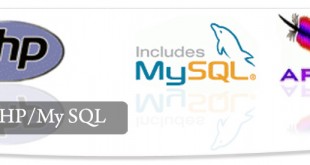Superglobals were introduced in PHP 4.1.0, and are built-in variables that are always available in all scopes.
PHP Global Variables – Superglobals
Several predefined variables in PHP are “superglobals”, which means that they are always accessible, regardless of scope – and you can access them from any function, class or file without having to do anything special.
The PHP superglobal variables are:
$GLOBALS
$_SERVER
$_REQUEST
$_POST
$_GET
$_FILES
$_ENV
$_COOKIE
$_SESSION
This chapter will explain some of the superglobals, and the rest will be explained in later chapters.
PHP $GLOBALS
$GLOBALS is a PHP super global variable which is used to access global variables from anywhere in the PHP script (also from within functions or methods).
PHP stores all global variables in an array called $GLOBALS[index]. The index holds the name of the variable.
The example below shows how to use the super global variable $GLOBALS:
Example
<?php
|
|
$x = 75; |
|
$y = 25; |
|
|
|
|
function addition() { |
|
$GLOBALS['z'] = $GLOBALS['x'] + $GLOBALS['y']; |
|
}
|
|
|
|
|
addition(); |
|
echo $z; |
|
?>
|
In the example above, since z is a variable present within the $GLOBALS array, it is also accessible from outside the function!
PHP $_SERVER
$_SERVER is a PHP super global variable which holds information about headers, paths, and script locations.
The example below shows how to use some of the elements in $_SERVER:
Example
<?php
|
|
echo $_SERVER['PHP_SELF']; |
|
echo "<br>"; |
|
echo $_SERVER['SERVER_NAME']; |
|
echo "<br>"; |
|
echo $_SERVER['HTTP_HOST']; |
|
echo "<br>"; |
|
echo $_SERVER['HTTP_REFERER']; |
|
echo "<br>"; |
|
echo $_SERVER['HTTP_USER_AGENT']; |
|
echo "<br>"; |
|
echo $_SERVER['SCRIPT_NAME']; |
|
?>
|
The following table lists the most important elements that can go inside $_SERVER:
Element/Code Description
$_SERVER[‘PHP_SELF’] Returns the filename of the currently executing script
$_SERVER[‘GATEWAY_INTERFACE’] Returns the version of the Common Gateway Interface (CGI) the server is using
$_SERVER[‘SERVER_ADDR’] Returns the IP address of the host server
$_SERVER[‘SERVER_NAME’] Returns the name of the host server (such as www.vshakya.in)
$_SERVER[‘SERVER_SOFTWARE’] Returns the server identification string (such as Apache/2.2.24)
$_SERVER[‘SERVER_PROTOCOL’] Returns the name and revision of the information protocol (such as HTTP/1.1)
$_SERVER[‘REQUEST_METHOD’] Returns the request method used to access the page (such as POST)
$_SERVER[‘REQUEST_TIME’] Returns the timestamp of the start of the request (such as 1377687496)
$_SERVER[‘QUERY_STRING’] Returns the query string if the page is accessed via a query string
$_SERVER[‘HTTP_ACCEPT’] Returns the Accept header from the current request
$_SERVER[‘HTTP_ACCEPT_CHARSET’] Returns the Accept_Charset header from the current request (such as utf-8,ISO-8859-1)
$_SERVER[‘HTTP_HOST’] Returns the Host header from the current request
$_SERVER[‘HTTP_REFERER’] Returns the complete URL of the current page (not reliable because not all user-agents support it)
$_SERVER[‘HTTPS’] Is the script queried through a secure HTTP protocol
$_SERVER[‘REMOTE_ADDR’] Returns the IP address from where the user is viewing the current page
$_SERVER[‘REMOTE_HOST’] Returns the Host name from where the user is viewing the current page
$_SERVER[‘REMOTE_PORT’] Returns the port being used on the user’s machine to communicate with the web server
$_SERVER[‘SCRIPT_FILENAME’] Returns the absolute pathname of the currently executing script
$_SERVER[‘SERVER_ADMIN’] Returns the value given to the SERVER_ADMIN directive in the web server configuration file (if your script runs on a virtual host, it will be the value defined for that virtual host) (such as someone@vshakya.in)
$_SERVER[‘SERVER_PORT’] Returns the port on the server machine being used by the web server for communication (such as 80)
$_SERVER[‘SERVER_SIGNATURE’] Returns the server version and virtual host name which are added to server-generated pages
$_SERVER[‘PATH_TRANSLATED’] Returns the file system based path to the current script
$_SERVER[‘SCRIPT_NAME’] Returns the path of the current script
$_SERVER[‘SCRIPT_URI’] Returns the URI of the current page
PHP $_REQUEST
PHP $_REQUEST is used to collect data after submitting an HTML form.
The example below shows a form with an input field and a submit button. When a user submits the data by clicking on “Submit”, the form data is sent to the file specified in the action attribute of the
 V.Shakya Software Developer & Consultant
V.Shakya Software Developer & Consultant 


